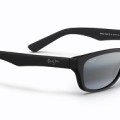
How to choose sunglasses for your summer holiday
Summer is coming. And you know what that means. Time to shape up. Ditch the takeaways. Hit the gym. Take your vitamins. Get more sleep. Kick the booze. 10,000 steps, every day, no exceptions, even if it means marching on the spot in the living room while you watch the latest must-see docu-drama that everyone’s talking about. Change your diet. Drink more water. Lay off the caffeine. Stretch. Try meditation. Try being vegan. Try yoga. And after all that has failed, buy some sunglasses and look fabulous anyway.
From a stylish pair of aviators to wide frame wayfarers and everything in between, there’s only one question. Why do the models in the glossy mag’s look stunning in shades while every pair – and just to be clear, that’s each and every single pair on the stand – you hang off your face looks like you’re playing dress up with costume accessories? Too big. Too small. Too red. Too wide. Too turtle shell. Too resting-on-your-cheeks-and-not-your-nose. Or, and this one is the worst, too sloping down to one side like one ear is higher than the other. Finding suitable sunnies is anything but the walk in the park they’re designed for. Well, the answer could be something to do with size. Let’s look at that first.
How to tell the size of a pair of sunglasses
If you don’t already know about this, the sizing info printed on the inside arm of a pair of sunglasses is going to be a revelation. There are three numbers. Sometimes more than three, actually, but those extra digits are just the manufacturer’s model numbers and batch numbers and such. You’re looking for three consecutive numbers, with the smallest number in the middle and the largest number at the end.
For example, the number might read something like: 50 – 22 – 135
The first number is the lens width (always given in millimetres). The second number is the bridge width. Lastly, the arm length. Who knew, right? With this new information, you may now proceed to try on and inspect all of the variously sized sunglasses you can find, until you find the perfect size for you.
It don’t mean a thing it you ain’t got that swing – we’re talking style choices
Your face is a shape. And that’s important in the world of sunglasses. Or perhaps your face is two shapes, sort of half and half. Now, take a deep breath, because this is going to come as a shock. All of the shapes sound awful. It’s true. Who wants a “round face” or a “square head”. Throw in words like rectangle, oblong, and even kite, and you’re really starting to sound like your noggin was carved from a potato in five quick flicks of a blunt butter knife.
To be fair, oval doesn’t sound too bad, but that’s just a nice way of saying ‘round but long ish too’. Heart shaped is another one that doesn’t sound particularly grim at first, but on second inspection is a backhanded insult about a pointed chin and jawline that recedes into the neck like the edge of an ice cream cone being slowly engulfed by the melting onslaught of a large single scoop.
Whatever your face shape, own up to it. Knowing the lay of the land is half the battle. Here’s what you need to know: sunglasses can introduce contrast and balance to your features.
- Round faces suit angled square-ish frames
- Square faces suit rounded-ish thin frames
- Thin oblong faces work best with rounded styles
- Heart shaped and triangular faces love a jaw-broadening aviator style
- Diamond shaped faces (with prominent cheekbones) work with rectangular wayfarers











